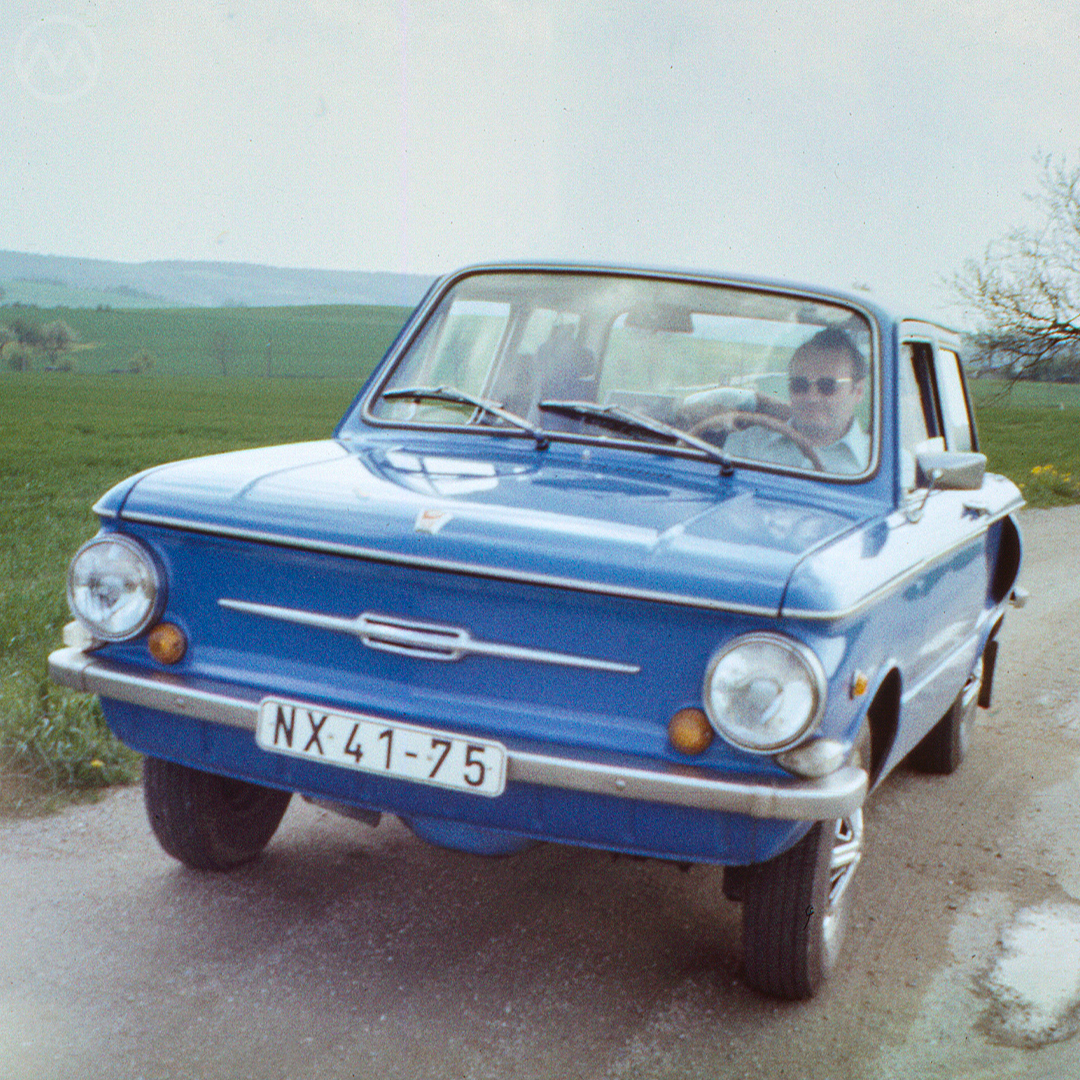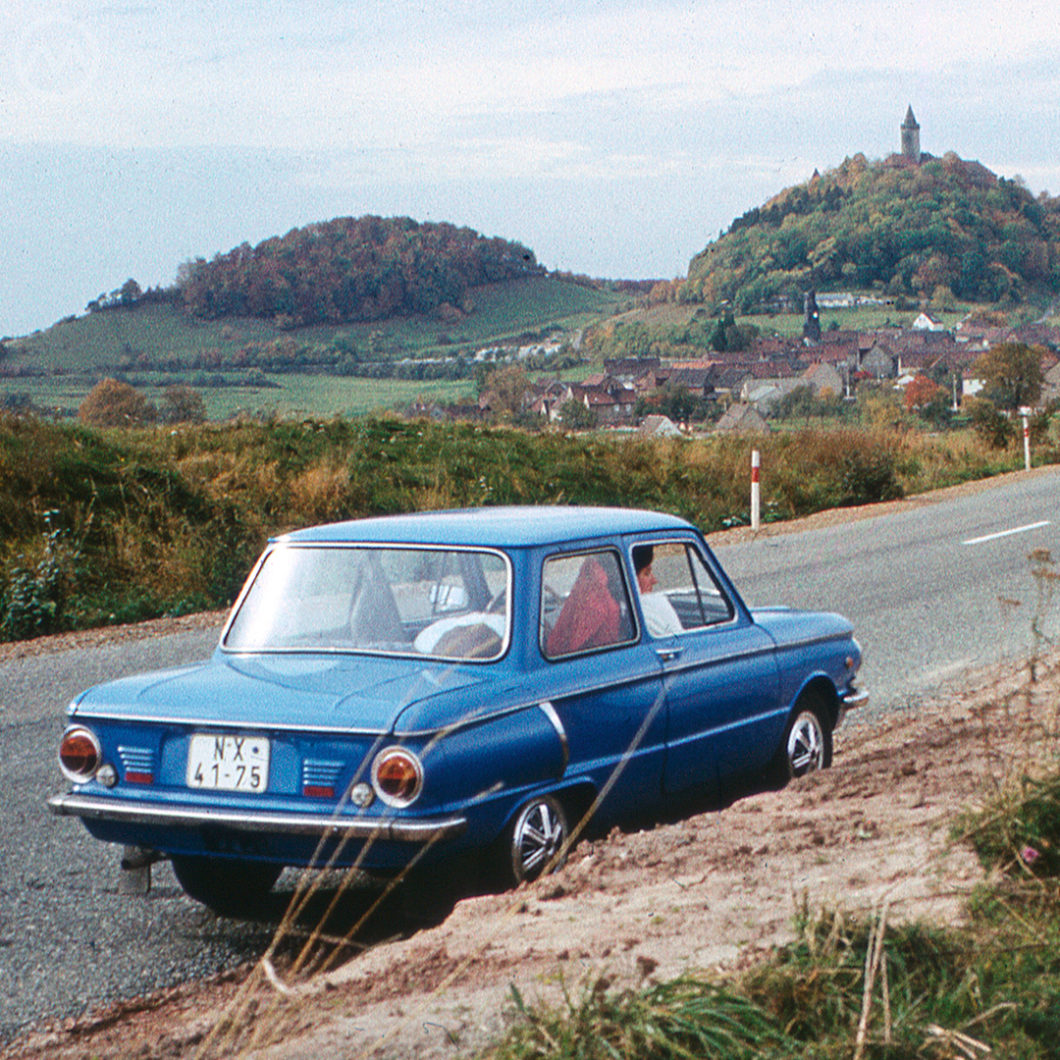While it was often associated with Russia in the west, and indeed it was the most common car on Russian streets before the advent of the Lada, the Zaporozhets was actually built in Ukraine, and in fact largely designed by Ukrainians. The star of today’s flashback is a Zaporozhets ZAZ-968A, seen here in some time in the late 1970s.
The 968A was an evolution of the earlier ZAZ-966, which first appeared in late 1966. Although calling this car “luxurious” stretches the limits of credulity, the 968A was genuinely meant to be a slightly more upmarket version of what was effectively the Soviet Union’s “people’s car.” The improvements consisted mostly of more chrome, a fancier padded dashboard, better brakes and those fancy hubcaps, but it was thought that this might make the car more appealing in countries like Poland, Czechoslovakia and the Deutsche Demokratische Republik (DDR or East Germany).
This is one of those export cars and it wears DDR plates from the district of Gera (part of Thuringia since reunification). While a common car in Russia and the other Soviet Republics, the car was designed and built in Ukraine by Ukrainians, in Zaporizhzhia on the Dnipro River.
From NAMI to Zaporizhzhia
What became ZAZ (or Zaporizhzhia Automobile Building Plant) dates back to the late 19th century and grew from two companies, a farm tool works in Zaporizhzhia founded by German Mennonite industrialist Abram J. Koop, and a machine works in Melitopol (about 50 miles south) founded by Ukrainian Izrail Zaferman, which built diesel engines from 1908. Both of these businesses ended up property of the state after the Ukrainian Civil War and Russian Revolution, but neither built cars or car engines until 1959, and then quite unexpectedly.
The first ZAZ, the adorable 965, was designed in Moscow at NAMI, the Soviet central scientific research automobile and automotive engines institute. While many of Russia’s early post-WW2 cars were based on appropriated western designs, NAMI centralized the planning and design of new vehicles. It was Russian Soviet minister Nikolay Strokin who had NAMI’s engineers essentially copy the Fiat 600 to produce a Soviet People’s car.
Originally, the ZAZ-965 was meant to be a Moskvitch product, but early on there were problems. Strokin and presumably other ministers dictated that the car use a tiny 746-cc air-cooled V4 designed for another NAMI project, an amphibious military off-roader called the LuAZ-867.
Contrary to popular myth, the V4 was not used as a starter motor for any tanks, but it was designed to be cooled by air coming in from the front intake. The 965 design was rear-engined and the motor barely fit, which necessitated major reworking of the suspension.
Finally, because Moskvitch had no room to build the car, production was farmed out to Zaporizhzhia in Ukraine, where prototypes were up and running in 1958 and preproduction began in late 1959.
This was Ukraine’s first car, but the 965 had a variety of engineering problems, and users disliked its suicide doors, saggy suspension, cold cabin and tendency to overheat. The first two years were spent by the Ukrainian team making lots of running changes to the 965, which led to 1962’s improved 965A.

Zaporozhets ZAZ-966 to ZAZ-968
But by then the Ukrainian team (under plant manager Yuri Sorochkin) had decided to replace it with a redesigned car built around the same pieces, with prototypes shown as early as 1961. The V4 was built at Melitopol (the plant then known as MeMZ), and they were stuck with it. The Soviet authorities would never have authorized a new engine or the resources to build it, so the V4 was gradually improved over time.
The new car was the ZAZ-966, which came online in late ‘66. Although no single designer is credited with it, it was very clearly influenced by Ned Nickles’ Chevrolet Corvair and the other European cars that followed, particularly the Hillman Imp and NSU Prinz.
The Ukrainians had ideas similar to Chevrolet too, and also developed a clever light van around the structure that mimicked the Corvair Greenbriar, but the ZAZ-970 never got into full production. It was vetoed by Soviet Ministers, who ordered ZAZ to keep cranking out the tiny cars. Later on, one of the engineers who created the 970, Leo Murashev, moved on to Lada, where he helped design the chassis for the Lada Niva.
Underneath, the 966 evolved the basic rear-engine 965 layout but made many improvements to the suspension, body structure, and even fitting a separate gas-fueled heater. One of the biggest changes was integrated into the styling – the huge ducts on the back, which help cool the now 887-cc, 30-hp V4 and earned the car the nickname “big ears.”
The 966B was the first improvement to the new car, with the larger 40-hp 1.2L engine and more speed, while the 968 arrived in 1971 with cosmetic tweaks and other running improvements.
The ZAZ cars were the first really affordable vehicles in the Soviet Union, and they proliferated quickly, keeping the Zaporizhzhia factory humming for years. They were loud and slow, but the torsion bar front and trailing arm rear suspension, with lots of travel, made them well suited to rough pavement and dirt roads, and they were bog simple to maintain. ZAZ kept improving them too.
The 968A, introduced in 1973 and built alongside the 968 for a couple of years, got more chrome, better brakes, and some other additions, including some concessions to modern safety equipment like a collapsible steering column and better safety glass. Production of the 968A continued through 1979, when it was replaced by the Zaporozhets 968M. This last version had more plastic and less chrome, but a few other technical updates. It served the longest, continuing in production until 1994.
The little Zaporozhets was also exported to Western countries, most notably Italy, France and the Low Countries, where it was sometimes called the Yalta, named for the Ukrainian resort city. Some importers also swapped out the V4 for a Renault engine, although how many were sold like this is unknown.

ZAZ Vs. Russian Bureaucrats
Of course, the Ukrainians had more ideas than just building this car for 26 years.
A front-drive car was proposed as early as 1963 by engineer Vladimir Steshenko, but the proposal kicked around for years without approval. It eventually became the 968’s replacement, the ZAZ Tavria, a front-drive, water-cooled modern Supermini developed in the late 1970s and benchmarked against the Mk1 Ford Fiesta.
Development of the Tavria took place from roughly 1976 to 1980, and it was reportedly ready for production by 1981. To improve it, engineers secure newer cars to spec it against, including the Austin Metro, but they were again blocked by Soviet Ministers, who endlessly debated whether or not it should go forward given that Soviet citizens were still buying plenty of Zaporozhets cars (2 million had been sold by 1982).
Notably, Zaporizhzhia’s engineers created this car on their own while Lada’s first front-driver, the Samara, was developed with some undercover help from Porsche. Soviet officials did not okay the Tavria until late 1982, and with the economy in shambles, production didn’t actually start until 1986 (and not in quantity until 1988, almost a decade after it was designed).
In the 1990s, many of these old cars were just thrown away, as they weren’t worth anything and to be frank, even cheap used western vehicles (loads of used Fiat Unos, Ford Fiestas and Peugeot 104s streamed into the former Soviet states in the early 1990s) were vastly superior technologically. It’s undeniably cute though, and a unique piece of Ukrainian history.
Editors note: we chose to post this story on the one-year anniversary of Russia’s illegal and immoral invasion of Ukraine. We stand with the people of Ukraine and all those who wish for freedom and peace.

